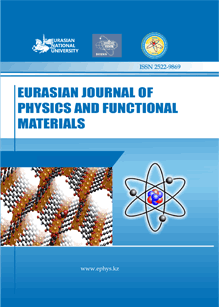The Eurasian Journal of Physics and Functional Materials is an esteemed international peer-reviewed (Double-blinded), open-access journal, established in 2017 through a collaboration between L.N. Gumilyov Eurasian National University (Astana, Kazakhstan), Republican Public Association "Physical-Technical Society" (Astana, Kazakhstan), and the International Intergovernmental Organization "Joint Institute for Nuclear Research" (Dubna, Russian Federation). The journal's primary objective is to offer authors from Kazakhstan and various other countries a platform to publish and engage in discussions regarding research outcomes in nuclear and particle physics, materials science, radiation ecology, and alternative energy. Since 2018, the Journal has been indexed in Scopus. Continuously adapting to the evolving needs and challenges of the scientific community, the Journal maintains a commitment to maintaining a high standard of quality and innovation in scholarly publishing. Its scope includes nuclear physics, alternative energy (including nuclear and hydrogen, photovoltaics, new energy sources, energy efficiency and conservation, and the environmental impact of the energy sector), and functional materials and related high technology issues. The Journal publishes articles in English on a quarterly basis (March, June, September, and December), encompassing original articles and review articles. Additionally, it is indexed in various databases including Index Copernicus International Ltd Poland, CrossRef (World), Google Scholar, Science Library Index (Meadow Springs, Mandurah State, Australia), Scilit (Basel, Switzerland), ResearchBib (World), Ulrichsweb, CiteFactor, DOAJ, Russian Science Citation Index (e-library), and the Committee for Quality Assurance in the Field of Science and Higher Education of the Ministry of Science and Higher Education of the Republic of Kazakhstan.
See the Aims and Scope for a complete coverage of the journal.
Current Issue: Volume 9, Number 4 (2025)
Original Studies
Photocatalytic Degradation of Brilliant Green Using ZnO Nanoparticles Synthesized via Green and Chemical Methods
Nur ‘Aamirah Syaamilah Alim, Malai Haniti Sheikh Abdul Hamid, Wan Nor Roslam Wan Isahak, and Ai Ling Tan
Study of the Hole Behavior Properties of ITO/ZnO/VOPc/MoO3 /Al Devices by Varying the Temperature and Thickness via Impedance Spectroscopy
Madhusudhana Ramanna, Roopadevi Puttaswamy, Ramya Puttegowda, Sachin Shivakumar, Vinaykumar Linganna, Ravikiran Ravikiran, Sachin Bandadka, and Guddappa Halligudra
Conceptual Design of the ARMAN Neutron Reflectometer at the WWR-K Reactor (INP, Almaty, Kazakhstan)
K.M. Nazarov; D. Kulikbayeva; R. Nurullin; B. Mukhametuly; , A. K. Bekbayev; M. Kenessarin; V.I. Bodnarchuk; A.V. Churakov; N.D. Zernin; S.M. Murashkevich; T.B. Petukhova; M.V. Avdeev; and Meir Yerdauletov
Studies on Machine Learning-Guided Prediction and Experimental Validation of Ni-Doped BaCO₃ for Energy Applications
Rekha G S and M. Anantha Sunil
Facile Synthesis of PEG- and Oleic Acid-Modified ZnO Nanoparticles for Potential Skin UV-Protection Applications
Christian Laurence E. Aquino, Salvador C. Buenviaje, Luigi A. Dahonog, Aian B. Ontoria, Aidrean P. Opaco, and Mary Donabelle L. Balela
Thermal protection composites based on phenol-formaldehyde resin and reinforcing fibers
Meiirbekov M.N., Sadykov M.Sh, Janikeyev M.S, Kuandyk A.B., Yesbolov N.B., and Nurzhanov M.N
Optimization of Photovoltaic Tilt Angles for Maximum Solar Energy Harvesting in a Tropical Savanna Region
Habib Ira Abdulaziz, Bala Abdullahi, Abdullahi Ahmed, Ibrahim A. Tukur, Suleiman I. Saliu, Clifford Baba Okpanachi, Abdulmutalib Omeiza Usman, and Mustapha Omenesa Idris


